Textile & Stitching Units Construction Company in Pakistan
Textile unit construction in Pakistan means creating modern spaces where fabric production, dyeing, and stitching work run smoothly. A textile or stitching unit includes cutting rooms, sewing lines, storage areas, and packaging zones all designed for efficiency. You can explore more about reliable construction services on Highland Properties & Construction.
Today, textile unit construction in Pakistan is growing fast, especially in Lahore, Faisalabad, and Karachi. These cities are the backbone of the country’s textile industry. Lahore’s new stitching parks, for example, show how smart layouts and proper ventilation can improve worker comfort and boost output.
Still, setting up a stitching unit construction project isn’t simple. Many industries face issues like heat control, ventilation, energy use, and compliance with safety standards. That’s why more textile companies are focusing on modern industrial construction to build stitching units that save energy, improve workflow, and support long-term growth.
Why Pakistan Needs Smarter Textile & Garment Factory Construction
Pakistan’s textile industry is the backbone of its economy it makes up almost 60% of exports and employs millions of workers across cities like Lahore, Faisalabad, and Karachi. But here’s the problem: many factories still run in old-style buildings that waste space, trap heat, and slow down production.
Modern garment factory construction in Pakistan is changing that. When factories are built with better airflow, wider stitching lines, and smart storage layouts, the difference is huge. Workers stay comfortable, energy use drops, and stitching output goes up.
For example, In Faisalabad, one local textile unit upgraded its stitching section with better insulation and organized machine placement. After the changes, their power bill dropped by almost 20% in just three months. It’s a simple reminder that smart textile mill construction services can boost both performance and savings.
Key goals for modern textile and garment factory construction include:
1. Safety: Fire exits, ventilation, and worker-friendly environments.
2. Workflow efficiency: Easy movement between cutting, sewing, and packing areas.
3. Sustainability: Energy-saving lights, insulated walls, and water recycling systems.
Pakistan’s textile future depends on smart, well-planned spaces that help both people and production work better, not harder.
Planning the Perfect Sewing Unit Layout Design
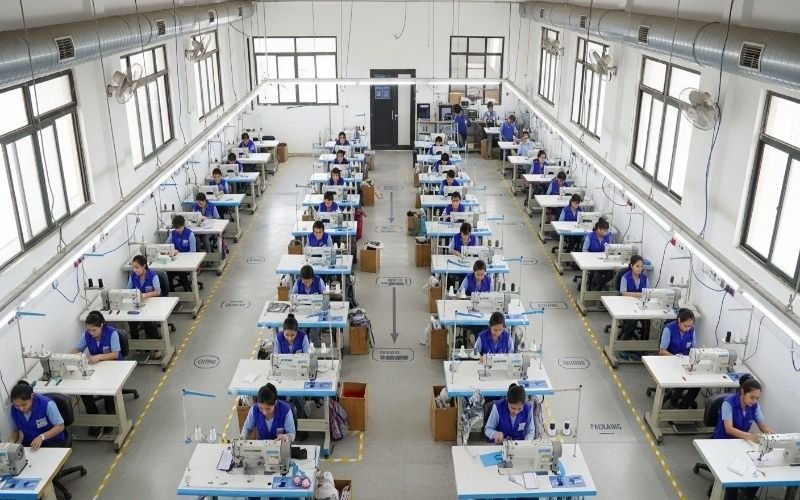
Getting the sewing unit layout design right is one of the most important steps in setting up a textile or garment factory. A well-planned layout helps save time, reduce worker fatigue, and increase stitching output. It’s not just about fitting machines it’s about creating a smooth, safe, and comfortable flow from start to finish.
When a layout is planned carefully, every inch of space works better. For example, placing the cutting, stitching, and finishing areas in a proper line saves hours of back-and-forth movement every day. That means faster work and happier workers.
1. Space Planning for Smooth Workflow
A smart layout keeps materials moving in one direction from cutting to packing. Try to keep aisles wide enough for trolleys and set up clear zones for stitching, pressing, and quality checks.
Tip: Make a simple floor map before installation. Even a small change in machine placement can boost daily output.
| Process Area | Main Activity | Key Considerations |
|---|---|---|
| Cutting Section | Fabric cutting and sorting | Spacious tables, proper lighting |
| Stitching Section | Sewing and assembly | Machine spacing, power supply |
| Finishing Section | Pressing, trimming, inspection | Ventilation, workflow flow |
| Packing Area | Folding and labeling | Easy access to dispatch zone |
2. Natural Light, Ventilation & Power Setup
Good airflow and bright spaces help workers focus better. Add skylights or windows for natural light, and plan separate power lines for each stitching row. This reduces wiring mess and improves safety.
3. Safety Zones and Worker Comfort (Pakistan Accord Standards)
Following Pakistan Accord safety rules is key. Add fire exits, first-aid areas, and shaded rest zones. Comfortable workers produce better results — always.
From Blueprint to Reality – Turnkey Textile Plant Construction
Building a textile unit from scratch can feel overwhelming but that’s where turnkey textile plant construction makes life easier. It’s a complete “design to delivery” process where one team handles everything from layout drawings to final machine setup. This saves time, reduces confusion, and keeps your textile factory ready to run faster.
The process usually works in three clear steps:
1. Design: Experts study your production goals and create a smart, efficient plan for space, structure, and utilities.
2. Build: Civil construction starts with a strong foundation, durable roofing, and proper insulation to handle Pakistan’s weather.
3. Fitout: MEP (mechanical, electrical, and plumbing) systems, ventilation, safety, and lighting are installed to make the unit production-ready.
Project, In 2024, Highland Properties & Construction completed a 50,000 sq. ft stitching unit for Ghani Textiles in Faisalabad. The turnkey approach covered civil, MEP, and fire safety works under one plan, helping the client reduce project delays by nearly 30% and achieve smoother operations from day one.
Turnkey textile construction keeps every part of your project aligned, so you don’t have to deal with multiple contractors or missed deadlines. Learn how turnkey construction services simplify complex industrial builds and get your textile plant ready faster.
Smart Industrial Building Design for Textile Factories
When it comes to industrial building design for textile factories, every detail matters from structure and safety to how machines and workers move inside the unit. A smart design not only saves time but also keeps operations safe and efficient for years. In Pakistan, where textile production runs almost nonstop, a well-planned building can make a huge difference in performance and energy use.
1. Structural Strength and Fire Safety (Pakistan Accord)
Textile units need strong frames, fire-resistant materials, and wide exits. Following the Pakistan Accord fire and building safety standards is a must. It ensures workers are protected and the facility meets international export requirements.
2. Reinforced Flooring & Machine Load Capacity
Heavy machines like stitching lines and boilers need solid flooring. Reinforced concrete floors with load-bearing designs prevent cracks and long-term damage. Always calculate the total machine weight before planning flooring thickness.
3. Prefabricated or RCC – Which Is Better?
Both options work, but it depends on your budget and timeline.
| Type | Best For | Benefits | Limitations |
|---|---|---|---|
| Prefab Textile Units (Pakistan) | Quick setup, short-term expansion | Fast to install, lower cost | Less flexibility for future changes |
| RCC (Reinforced Concrete Construction) | Long-term textile plants | Strong, durable, better insulation | Longer construction time, higher cost |
Prefab textile units in Pakistan are great for startups or fast-scaling stitching setups, while RCC structures suit large, permanent factories.
Essential Systems – MEP & Utilities in Textile Mill Construction
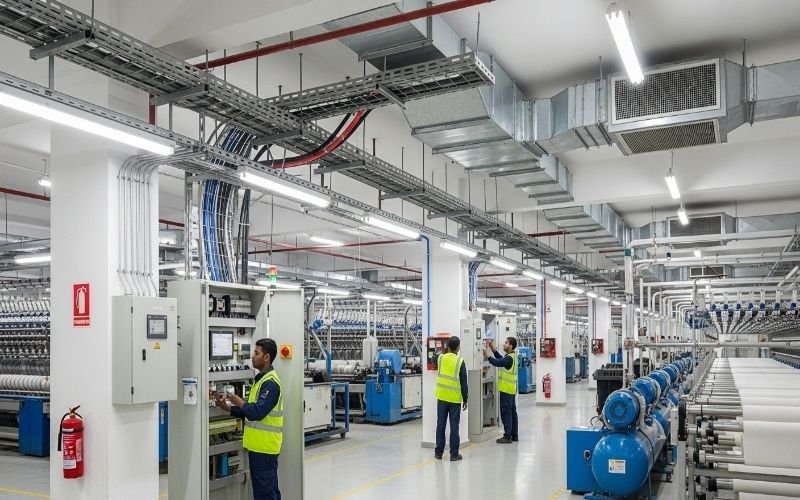
Behind every smooth-running textile unit, there’s a well-planned MEP system that’s mechanical, electrical, and plumbing. In simple words, these are the systems that keep machines working, lights on, and the factory safe for everyone. Good MEP for textile factories means fewer breakdowns, better energy savings, and full compliance with safety standards.
1. Power Load Planning for Heavy Machinery
Textile machines use a lot of power from stitching lines to air compressors. It’s important to calculate total load before construction starts. Proper wiring, backup generators, and separate control panels help prevent overloads and keep production steady.
2. HVAC for Temperature Control
Textile areas get hot fast due to steam, motors, and lights. A strong HVAC system helps control humidity and keeps fabric in good condition. It also improves air quality for workers, which directly boosts productivity.
3. ETP and Wastewater Systems for Compliance
Every textile mill must manage wastewater safely. Installing an ETP (Effluent Treatment Plant) keeps operations eco-friendly and follows national and international safety standards, including garment factory safety Pakistan Accord.
Smart MEP design keeps the entire textile mill running safely and efficiently saving both energy and maintenance costs in the long run.
Beyond Construction – Fit-Out & Sewing Machine Shop Setup
Once the main building is complete, the next big step is fit-out and sewing machine shop setup. This phase turns a plain structure into a working textile or stitching unit. It’s where lighting, furniture, storage, and machine placement all come together to make daily work smooth and efficient.
Good lighting is key bright, even lights help workers see fabric details clearly and reduce eye strain. Furniture like adjustable chairs and proper cutting tables also matter more than most people think. They keep posture correct and help workers stay comfortable during long hours.
Storage areas for threads, fabrics, and finished garments should be close to the production floor. A smart layout reduces walking time and keeps everything within easy reach.
For example, an ergonomic workstation setup with chairs at the right height and foot pedals properly aligned can boost stitching speed and reduce worker fatigue.
In simple words, a good sewing machine shop fitout means better comfort, faster production, and fewer mistakes. It’s not just about looks it’s about creating a space that helps people work better every single day.
Why Choose Prefab Textile Units in Pakistan
In today’s fast-moving textile market, time is money. That’s why many companies now prefer prefab textile units in Pakistan instead of traditional builds. These ready-to-install structures are made off-site and assembled quickly, saving both time and cost without compromising on quality.
Prefab units are especially popular in industrial parks where export factories need to start production fast. Many stitching and garment units in places like Faisalabad and Lahore are now shifting to prefab setups because they’re easier to expand when demand grows.
Here’s why prefab textile units are a smart choice:
1. Fast installation – projects complete in weeks, not months.
2. Lower cost – reduced labour and material waste.
3. Durable design – weather-resistant and long-lasting.
4. Easy expansion – add new sections anytime with minimal downtime.
Prefab builds help you scale faster, stay compliant with Pakistan Accord standards, and make better use of your investment.
Conclusion – Building a Future-Ready Textile Industry
The future of Pakistan’s textile sector depends on smart planning and strong infrastructure. With the right textile mill construction services, factories can become safer, faster, and more sustainable ready to compete in global markets.
A well-built textile unit isn’t just about walls and machines. It’s about:
1. Safety that meets Pakistan Accord standards.
2. Efficiency through better layouts and MEP systems.
3. Sustainability with energy-saving designs and wastewater control.
Pakistan’s textile market is growing quickly, and companies that invest in modern construction now will lead tomorrow.
If you’re planning to build or upgrade your textile or stitching unit, it’s the right time to take expert guidance. Explore our architectural design solutions and start your project the right way.
➡️ Learn more about professional textile mill construction services and start building your future-ready facility today.
FAQ – Textile & Stitching Units Construction in Pakistan
These are some common questions people ask before starting a textile or stitching project.
Q1: What is the Average Cost of a Stitching Unit in Pakistan?
Answer: The cost of building a stitching unit in Pakistan depends on size, location, and materials. On average, a medium-sized stitching unit (around 30,000–50,000 sq. ft) can cost between PKR 2500 to 4000 per sq. ft. Prefab textile units in Pakistan are usually cheaper and faster to set up compared to RCC buildings.
Q2: How Long Does it Take to Build a Textile Factory?
Answer: It usually takes 6 to 12 months to complete a textile factory, depending on the design and construction type. Turnkey textile plant construction can speed up the process since everything from civil work to MEP installation is managed under one team.
Q3: What are The Safety Standards for Textile Buildings Under Pakistan Accord?
Answer: Under the Pakistan Accord, all textile and garment factories must follow strict safety guidelines. These include fire exits, ventilation systems, emergency lighting, and structural strength checks. Meeting these standards keeps workers safe and helps export factories meet global compliance requirements.


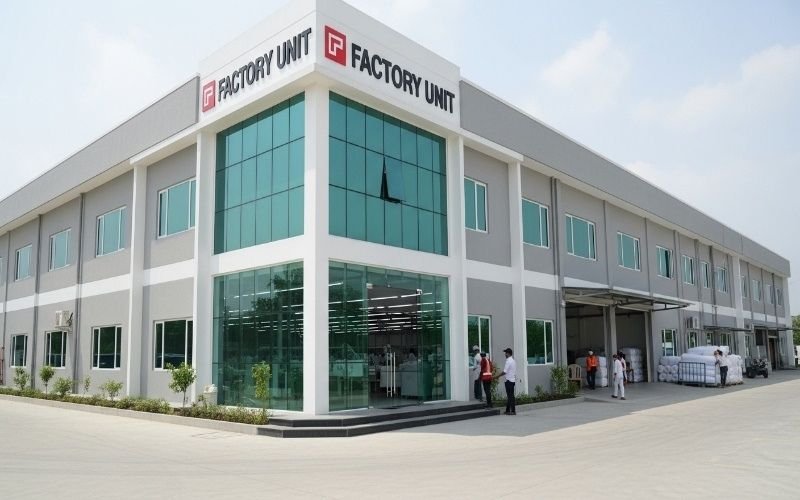
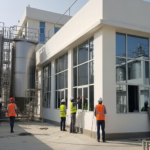
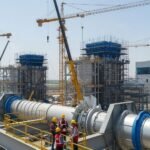
Leave a Reply